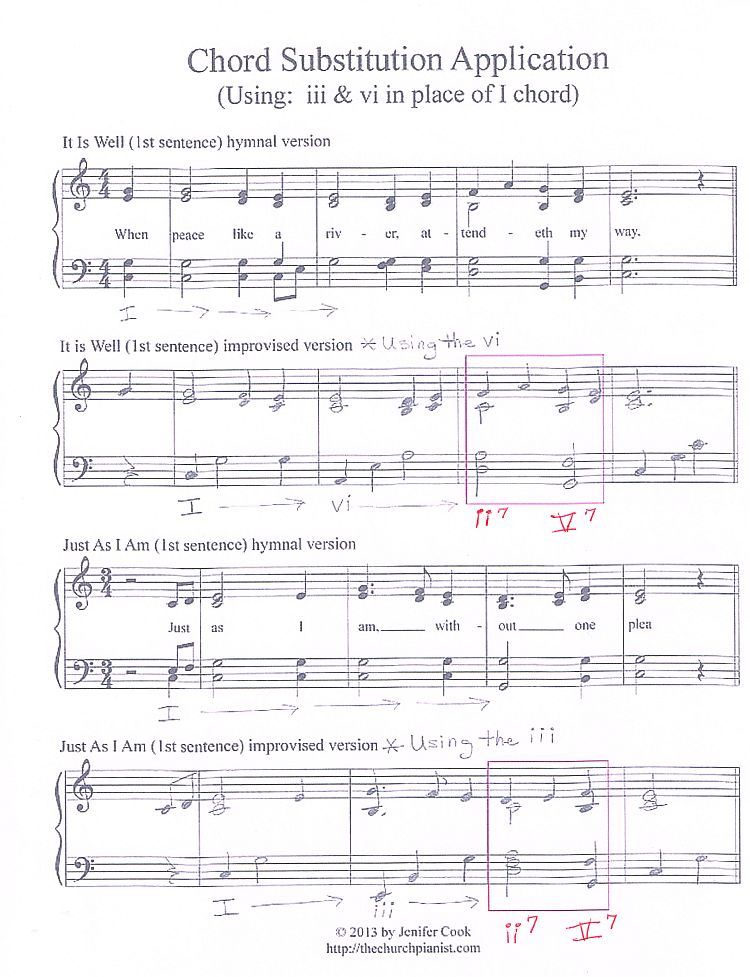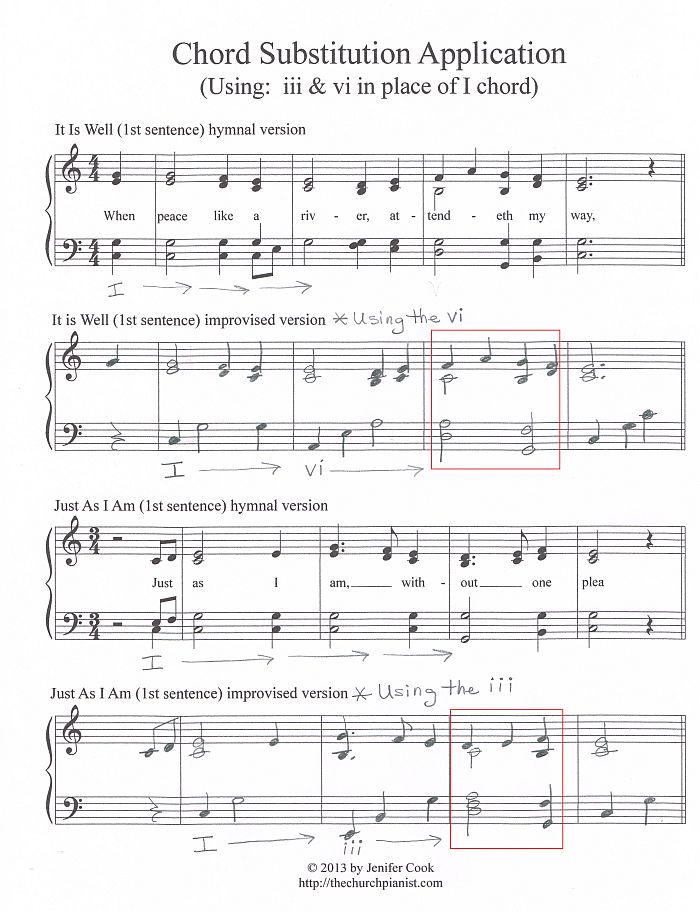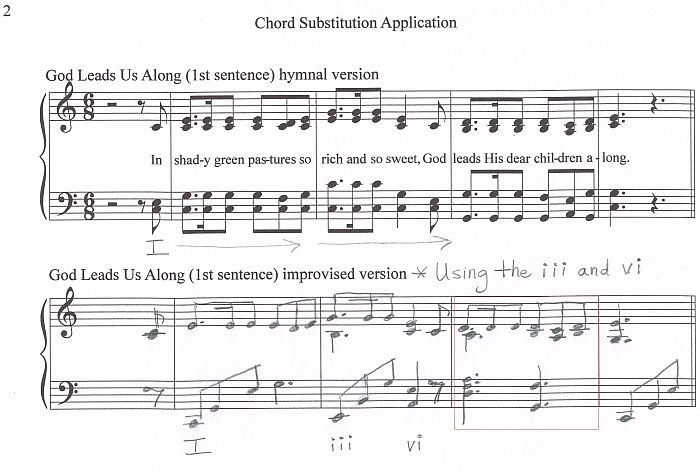Color Up Your Hymnplaying with this Color Chord Combo!
Friday, September 9th, 2022Warning! Pause and reverse as needed for this short tutorial!
| The Church Pianist |
| A help ministry for church pianists all over the world! |
Church pianists enjoying bringing hymns to life by adding different chords! A recent question from one of my readers has created the perfect opportunity for me to share tips on chord substitutions….a topic I’ve been wanting to deal with for quite some time. Chord substitutions can add such color to a song! It’s a very B-R-O-A-D topic; meaning….there’s an endless supply of chord possibilities in any given key!
Reader’s Question:
“I have been using various resources trying to learn more about theory, but I haven’t found any that go beyond a basic level.
For example, I know what augmented and diminished chords are, but I don’t know how to use them or how they fit into functional harmony. In analyzing your arrangements, I have noticed you use a lot of different kinds of chords, such as chords with altered bass notes or a I-ii half diminished-I-etc. progression for introductions.
How did you learn how to use all these? Do you have any recommendations for resources that would teach me more? Any advice would be appreciated!”
Ashley
Hi Ashley,
How did I learn to use different chords from the written music? You won’t like my answer 😉 I play them by ear…basically whatever sounds right. I do know chord theory but don’t think about theory application when playing….I just….play 😉 (Music writer’s confession: I don’t claim to be an expert theorist.)
For everyone’s benefit…the “different” chords we’re discussing are called chord substitutions. A chord substitution occurs when replacing a chord with a different chord.
Easiest Chord Substitution for Starters…
To replace a major chord within a key…use the chord a 3rd above or below the root note of a major chord. (The major chords within any key is the I, IV and V).
The I chord in the key of C Major is the C chord (CEG). Now, what note is a 3rd above C ? E…so the e minor chord (EGB) within the C scale can be used as a substitution as long as it “sounds” good within the occurring chord path (progression) of the song. Count a 3rd below C and you find A. The A minor chord (ACE) is the second choice for a C major chord substitution.
Two observations about these two chord substitution choices:
1. They’re both minor
2. They each have two notes in common with the chord being replaced
There are other types of chord substitutions but wanted to start with the easiest kind.
Extra Information:
1.The chord substitution just described above (3rd above or 3rd below) is called the Diatonic Substitution. A diatonic chord substitution occurs when using different notes within a scale. It’s the most natural form of chord substitution because no note alterations take place; just using what ingredients are already available within that key 😉
2. The key signature and melody of any song dictates what chord(s) can be used.
♫ Chord Substitution ♫
Replacing the V7 with a ii7
Chord substitutions work best when enough time is allowed. For example, when a V7 chord lasts for two or more beats…there’s time to replace it with a different chord. The ii7 can replace the V7 and still resolve back to the original (V7) chord.
For example, in the key of C Major…the V7 is GBDF and the ii7 is DFAC
In the following examples, the hymnal version is displayed along with the improvised version showing the substituted chord.
I did not label the V7 chord in the hymnal version of each example that lines up with the substituted chord in each improvised version. I will tell where they occur:
It is Well…on the syllables “tend-eth my” and for Just As I Am…”-out one” (before “plea”)
*Keep in mind…I’m using the same sheet as I did in the previous lesson on chord substitutions for the I chord.
The ii chord substitution is hand-written in red under the measures with a red square around them. I also labeled the V7 chord under the red square examples so you could see where the ii7 resolved back to the V7.

![]()
Answers from previous quiz questions for Chord Substitutions:
Minor chords for IV are ii and vi
Minor chords for V are iii and vii
Key of C Major: F chord is the IV chord….so…d minor is the ii chord and a minor is the vi chord. The V chord is G….so….e minor is the iii chord and b minor is the vii chord.
Review from last lesson: A Major chord lasting two or more beats can be substituted with a minor chord. Go up or down two chords from the Major chord to find its minor chord substitutions.
For example: The C Major chord can be substituted with an e minor or a minor chord. (The melody note dictates which substitution will sound right).
This is only the beginning…there are SO many chord substitutions! I’m just covering the basic choices.
Warning label to the church pianist: Chord substitutions cannot be used for congregational singing IF the congregation is singing parts from hymnal.
Chord substitutions can be used for solo instrumentals or when accompanying vocalists or instrumentalists singing or playing the melody.
Reason for selective use: chord substitutions do not support the written voice parts in a hymnal.
Our church has a small congregation that mainly sings melody with occasional tenor….giving me more freedom in congregational accompaniment. Adding chord substitutions just brings what would be a plain hymn…to life!
If you’re a church pianist wanting a warmer sound to your playing…chord substitutions are the answer! I use a lot of chord substitutions during invitation..creating a more reflective mood. Our pastor likes background music during the entire invitation…allowing me more freedom to alter the melody and chords.
The following chord substitutions would be better understood if the church pianist had a basic understanding of being able to analyze chords within a hymn…hence….another lesson in the works 🙂
Until then…enjoy learning a couple chord substitutions for the following hymns.
Layout explanation: Three different hymn examples; each hymn is represented by an original line from the hymnal followed by an improvised version of that line. The I (CEG) chords are labeled as well as the substituted chord numbers. Each example is in C Major. *Measures marked with a red square require future post to explain.


Page one: Chord Substitution Application
Page two: Chord Substitution Application
Time to apply what was taught in lessons one through four on “How to Add Chord Substitutions”.
The following visual aid of the C Major scale and its chords will be helpful for this lesson!
Notice once again: The Major chords above are indicated by an upper case Roman numeral. The lower case Roman numeral indicates a minor chord.
Now for the fun part!…You’re about to learn how to find chord substitutions!
The bottom line: The three major chords listed above in the key of C: I, IV and V can be substituted with a minor chord. How do do this?
Look for a minor chord that has at least two notes in common with a major chord. For example: A iii chord (EGB) has two notes in common with the I chord (CEG). That means….a iii chord can replace a I chord in the right setting.
Ok….can you find the other minor chord that has two notes in common with the C (I) chord? Yes! the vi (ACE)
Your Quiz:
1. Find the two minor chords that have two notes in common with the IV chord.
2. How about the two minor chords that are compatible with the V chord?
~~~~~~~~~~~~~~~~~~~~~~~~~~~~~~~~~~~~~~~~~~~~~~~~~~~~~~~~~~~~
So…when to use the chord substitutions? When a major chord lasts for two or more beats…there is time to use a minor chord substitution! The melody note also dictates which substituted chord will sound right. (Hint: The left hand plays the chord substitution and the right hand may have to alter the alto note to match the substituted chord. (When playing from the hymnal)
*Special note: (Observation from one of my readers)…Just go up or down two chords from a Major chord to find its minor chord substitutions. (Thanks Victoria!)
I will provide visual examples in the next article!
Answers to Lesson Three’s Assignment on Major and minor 3rds:
D flat to F (Major 3rd)
C to E flat (minor 3rd)
G# to B (minor 3rd)
B to D# (Major 3rd)
Now that you’ve learned Major and minor 3rds…you’re ready to apply this knowledge to the scale-based triads of any Major scale.
For ease of application, I’ll use the scale-based triads of the C Major scale listed below.
Notice that the triads either have an upper case or lower case roman numeral. Upper case indicates Major chord and lower case means minor chord. All Major scales have the same chord numbers.
For example, in G Major (which has one sharp)…the I chord would still be a Major chord and the ii chord would be minor, etc.
Now for applying your knowledge of major and minor 3rds…
1. A Major chord consists of a Major 3rd plus a minor 3rd. For example: the 1st chord in the C scale (I) is a C chord (CEG). From C to E is 4 half steps and from E to G is 3 half steps.
Remember: a minor 3rd consists of 3 half steps and a Major 3rd consists of 4 half steps.
So…from C to E is a Major 3rd and E to G is a minor 3rd. A Major 3rd plus a minor 3rd = a Major chord!
2. The minor chord ingredients are just the opposite of a Major chord….a minor 3rd plus a Major 3rd = a minor chord!
(See Lesson Three for more details)
With the knowledge learned in lessons one through four….you will be able to learn some VERY EASY chord substitutions! Can’t wait for the next lesson! The fun will begin 🙂 Review lessons one through four so you’ll be ready! See links below for each lesson:
Lesson One
Lesson Two
Lesson Three
Reviewing Lesson Two
Here are the essential tools I’ve covered so far as prerequisites to adding chord substitutions:
Understanding the major scale (C scale was our example for ease of application) There are 8 notes in a scale.
The scale-based triads (3 note chord)
Term: Interval (distance between two notes)
Answers to lesson two’s intervals:
*D to F (3rd)
*C to G (5th)
*B to G (6th)
*G to C (4th)
Lesson Three: Half and Whole Steps
What if I play a D to the next F#…is that still a 3rd interval? Yes it is! So…what’s the difference between a D to F and a D to F#? Well, a D to F is a minor 3rd and a D to F# sharp is a Major 3rd. How do I know that? I learned about half and whole steps; used to create minor and major 3rds.
(The following lesson must be understood before you can identify minor and major 3rds.)
A half step is from one note to the very next (closest) note. For example: a C to C# is one half step. Or….E to F is a half step…no key between the moves.
A whole step is from one note to the next neighbor note…such as C to D or F# to G#. (A whole step has one key between its two notes)
C to D has a black key between them. F# to G# has a white key between them and B flat to C has a white key between them.
Very important lesson to remember!
Several Reasons why:
Because scales are made up of half and whole step patterns
What if someone says….”transpose up a half step”…must understand!
Major and minor chords are determined by number of 1/2 steps! (next lesson)
Understanding of sharp and flat notes (they move by 1/2 steps)
Now for the application of half and whole steps…
A minor 3rd = 3 half steps
A Major 3rd = 4 half steps
Assignment:
Identify the 3rds below the example as either minor or Major
Example: F to A = Major 3rd
(the numbers indicate the half step moves)
Hint: 1st half step counts after first note
D flat to F
C to E flat
G# to B
B to D#
Learning these theory lessons WILL help you know how to add chord substitutions. Just hang in there and take good notes 😉
Chord substitutions add SO much color to gospel songs! Gospel songs contain infrequent chord changes. Songs like: Revive Us Again (mentioned in lesson one), Wonderful Words of Life, Work for the Night is Coming, to name a few.
In lesson one, you learned the numbering system for the scale and its scale-based triads (3-note chords).
Now…forget scales for a moment: you’re ready to learn another easy concept also dealing with numbers…the term: INTERVAL
The word: INTERVAL means the distance between two notes. To count the distance between two notes…you start counting from the first note to the second note you land on. For example, F to the very next G. F counts one, G counts two. So…from F to G is a 2nd interval. How about from F to the very next A….F counts one, G two…and A three…a 3rd interval.
So, pack this lesson away in your mind for future application! Why? It will be necessary when we place chords in consecutive 3rds to determine what root chord we’re dealing with so we’ll know what chord substitution will work. Make sense? If not, that’s why it’s important to save these preparatory lessons in order to know how to add chord substitutions to gospel songs.
In the meantime, try to answer the following by guessing the correct interval for:
D to F
C to G
B to G
G to C
*Answers will be provided in the next lesson 🙂
Also, here’s a free online interval worksheet to do for extra reinforcement: INTERVAL WORKSHEET (Opus Music Worksheets)
*Tip: On this free worksheet…Unison (U) is mentioned in the directions. Unison just refers to two identical notes (just as we refer to a choir singing unison…all on the same note)
Please feel free to ask questions! Extra interval visual below!
I found this neat picture at: Visual Dictionary
One of my readers recently asked if the chord substitutions of Just As I Am tutorial video was available in sheet music. I have since created the sheet music for this brief lesson.
Click on the following link to see the video of Just As I Am chord subsitutions for the final line of this soul-stirring invitation hymn. I use the minor chord substitutions in this hymn…to give it a warmer sound.
Just As I Am (video link: chord substitutions)
Click here for free sheet music of Just As I Am chord substitutions
Free Piano Arrangement of Just As I Am (invitation background style)